Last time, I talked about the effect of my long camino trek on my toes and feet. As much as I prepared for my walk, I still got blisters. Breaking in my trail shoes, wearing good fitting socks, and mindful packing of my backpack did not prevent them. Oh well, I accepted my fate and made the decision – choice – to continue my pilgrimage to Santiago.
My story continues.
Warning: this post contains images of ailing feet.
🐜 🐜 🐜
At the end of the last post, I asked the question…
How Did My Toes and Feet Hold Up?
Here is what I experienced.
Since many stages or distances between towns were long, any cafe or public park with a bench was my port in the storm. They provided any combination of water, food, and rest. Often there were no services in the desolate or virtually abandoned towns along the trail. Otherwise I stopped where I could, on a big rock or on the ground.
Certainly, it was not always convenient. Whenever and wherever I could, I removed my shoes, changed my socks, dried, massaged and rested my toes and feet.
Ants and things
Outside, ants and flies were attracted to this rotten flesh.
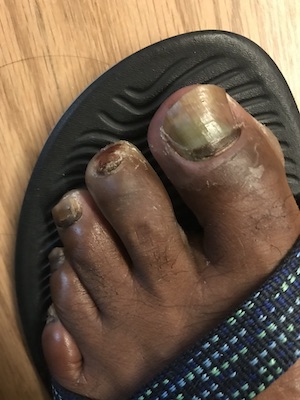
On the ground they walked all over my shoes and feet. I continuously knocked them off my mangled toes. It seemed like a lost cause. But I did not panic.
To relieve the pressure of swelling on my big and second toes, I pierced them with a sterilized pin to release the accumulated liquid. I washed and sprayed all my toes with disinfecting spray and covered them lightly with gauze.
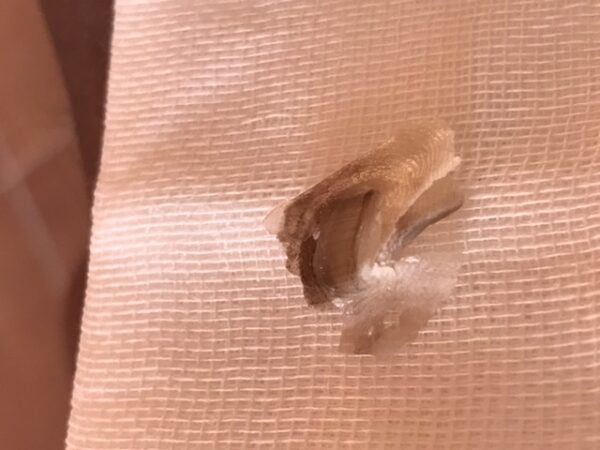
After a swig of water and bite of food from my backpack, I redressed my feet. I stood up, delicately, and took that first painful step to continue on my journey. It took about 100 steps in my estimation, for the pain in my feet to get back to its new normal and for my toes to readjust to walking.
My walking stick helped me navigate the tricky surfaces along the way. I stepped lively and lightly up and down mountains, on paved roads, sharp ancient riverbeds, rocky and wet trails, muddy surfaces, and tiled sidewalks. I never limped.
There Is More
Occasionally – let me take that back – frequently I stubbed my toe on a rock or an imbedded boulder that seemingly came out of nowhere. Of course, I had my shoes on but that blow stung nonetheless. My poor feet were already in pain. These impacts shook my entire body, bringing tears to my eyes. Just when I thought I was diligent, trying to make sure it did not happen again, it did. I experienced this at least eight times a day. Once I counted eleven.
It could have been funny if it did not hurt so much.
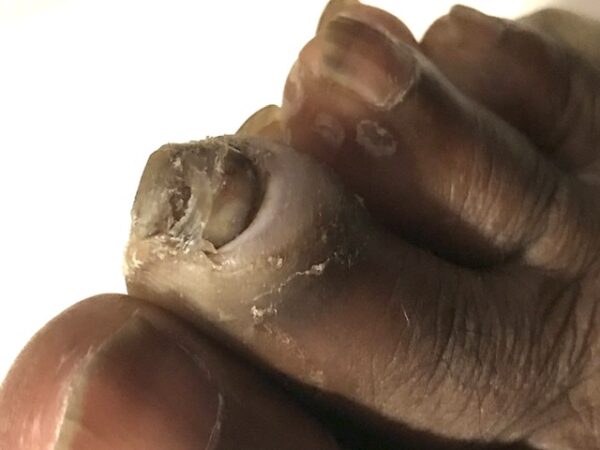
Now I adopted a new routine, wrapping my toes with lambswool or using foam toe guards. That was a chore. Sometimes I was so wrapped up (no real pun intended; it is funny though) with attending to my blisters in the morning that I forgot about my toes until I stubbed them again.
That was a painful reminder!
I lost six toenails by the time I ended my pilgrimage.
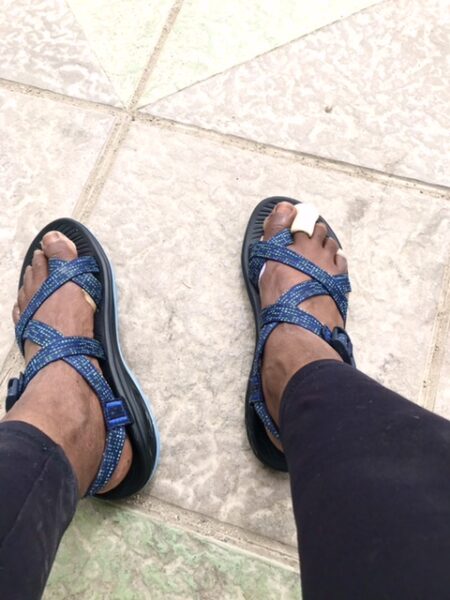
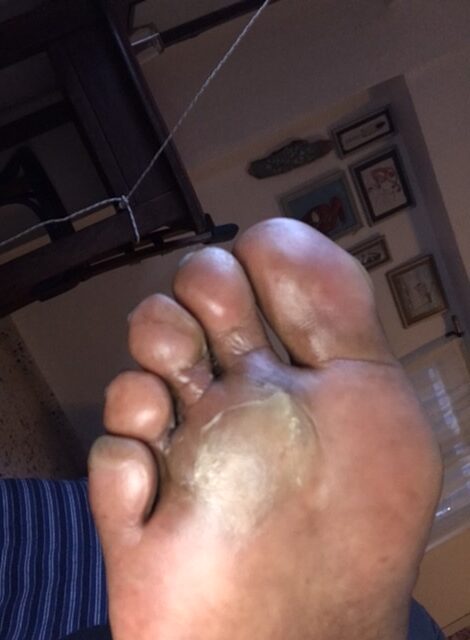
I was a regular customer at the farmacias or pharmacies. Hours did not always coincide with my arrival in a town. Siestas and Sundays had a lot to do with that. Also, some villages and towns did not have a farmacia or doctor.
I anticipated my medical needs and bought enough gauze, tape, disinfecting spray, and ointment to last for several days at a time. I had my tiny blunt point scissors to cut the tape, gauze, and trim away “dead” skin.
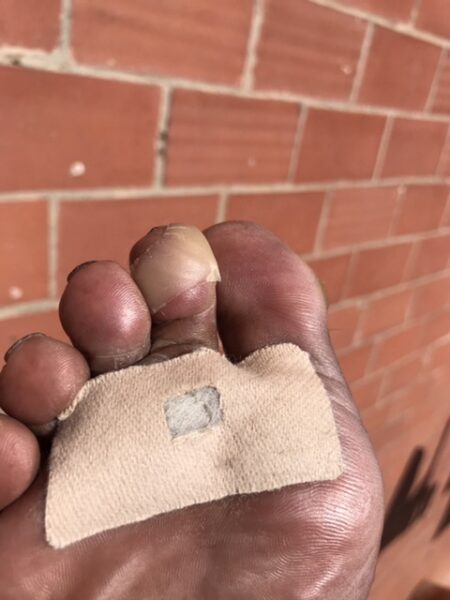
In the quasi-communal setting of the albergue, there is not much privacy. Taking up too much time in the tiny banõ or bathroom shared by everyone in the place is not a good look. The common sitting areas or kitchen are not, for me, appropriate or sanitary areas for attending wounds. It was practical to sit at the edge of my bed. Outside was better because the sun and occasional soft breeze healed my psyche.
My goal always was to keep the space and myself as sanitary and clean as possible. I laid out my medical supplies so I could efficiently tend to my toes. I used sheets of newspaper to catch and dispose of old bandages and wrappings.
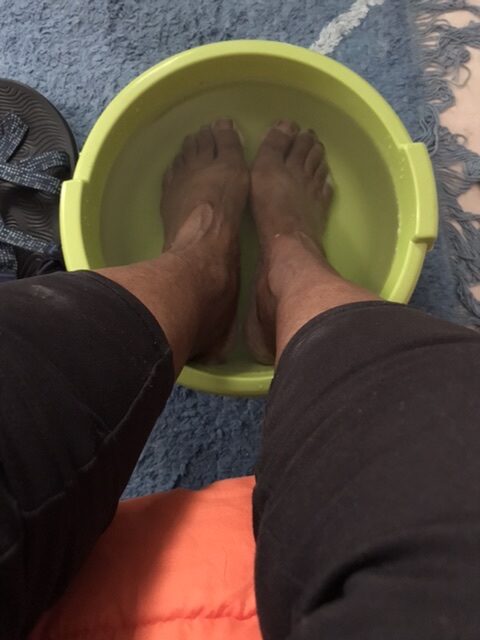
Contributing factors
Heat at this time of the year played a significant role in making these blisters. That is something that cannot be controlled. The rain, too, contributed to the mayhem on my feet. On the higher elevations, I encountered cool or even downright cold nights. That caused problems. My feet would not dry completely after a shower in the evenings. Often, I would go out to sit and let my feet dry in the sun remaining before it set.
Most albergues and hotels do not provide heat or allow the heaters to be turned on during the summer. Fortunately, I used a pair of loosely fitting sleep socks to cover my feet for protection and warmth. They absorbed a bit of water left after drying my toes with the thin weight efficient towel that I carried with me.
Sometimes I wore them with my sandals. It was not a pretty look, but my feet were protected.
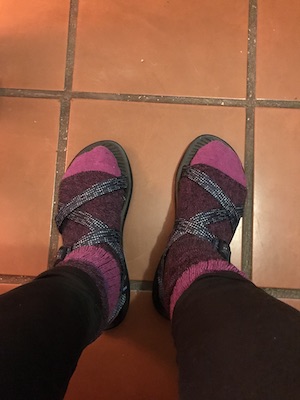
I could then leave the albergue and walk with my friends to find something to eat for supper. Really, my feet never felt dry.
Before lights out at the albergue, I rubbed my feet with antibiotic cream. In the mornings, I allowed time for wrapping my toes or simply laying on a little lambs wool between them. Then I taped the bottoms of my feet only where it was crucially needed.
Rocks In My Socks
Oh yes, I still had to put on my hiking socks! All of this was inserted into my shoes! It was rare that I got it right on the first attempt each morning. Before leaving the albergue, I test fit my shoes several times so I did not end up feeling like I was walking on lumpy rocks.
Soon, I performed this routine in the dark before the lights came on. Eventually, I made the decision to wean my feet from the bandaging in order to toughen and train them to heal. Some of my companions noted that I was walking a little faster.
Nonetheless, this was a mindful exercise in awareness and self care.
As you know, I arrived in Santiago de Compostela happy, mostly healthy and whole.
And I lived to tell the tale.
Today
I am recovering and grateful for the most personal souvenir I could have.
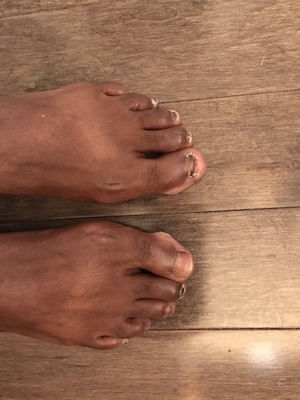
There was something I ought to remember: and yet I did not remember.
– D.H. Lawrence
I am still walking almost everyday and my toes and feet are getting better!
____
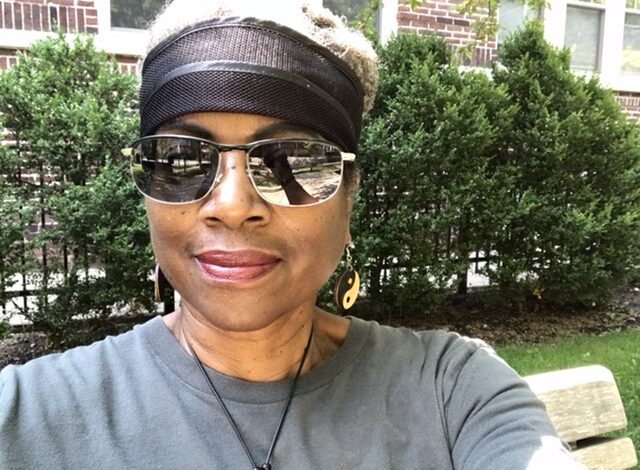
Shirley J ♥️
Read the rest of the stories about my pilgrimage to Santiago de Compostela, Spain: here.


2 thoughts on “👣 Praying With My Feet – Part 3”
That looks painful but they got you from point A to point B and that was the main goal.
Oh yes! But from point A to point… Z. Thanks for reading.🐜